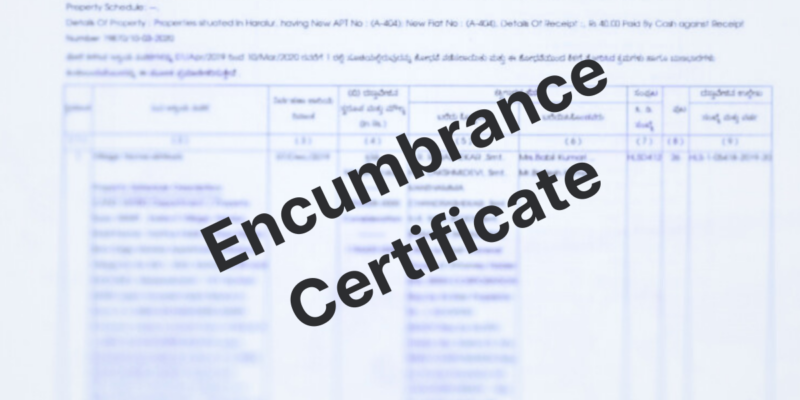
As a buyer, if you are wondering how to get legal information regarding a property, then an Encumbrance Certificate will help you find out if any legal issues are associated with that property.
An Encumbrance Certificate is a legal document that clarifies whether a particular property is free from any financial or legal burdens. It is an important document that is used as evidence of possession of a property. This certificate is required at the time of purchasing or selling a property, and also while applying for a home loan or loan against the property to confirm that it is free from any legal or economic liabilities.
Table of Contents
Importance of Encumbrance Certificate (EC)
This certificate proves that the property has no dues, and assures a buyer that it has a marketable title. The reasons to obtain EC are as follows:
- It validates ownership of the property and is required in all property-related transactions
- For home loans or loans against the property, banks and financial institutions ask for 10-15 years of EC. Hence, buyers must obtain it to secure their legal title and to prove their eligibility for a loan.
- It works as an assurance that the property is free from any dues
How to Obtain EC?
An Encumbrance Certificate is issued by the sub-registrar for a fixed period. You can either apply for an EC online or offline, submit the required details & documents, pay the fees & get the acknowledgement, and receive the EC after site inspection by the land records department.
Understanding Property Encumbrance
An Encumbrance Certificate is vital in real estate transactions. It provides insight into the property’s legal status and ownership history. It helps the buyer understand property encumbrance, which refers to any outstanding financial or legal obligations tied to the property. These encumbrances include mortgages, liens, unpaid taxes, easements, or pending legal disputes.
Types of Encumbrances
There are 2 types of encumbrance certificates:
- Form 15
- Form 16 (Non-Encumbrance)
Form 15 is provided if the property’s sale, mortgage, and other deeds are registered with the same region’s sub-registrar. It provides all the transaction details under the owner’s name for a specific time. It also includes the details of the type of encumbrance, such as lease, partitions, gifts, involved parties, registration number, and more.
Form 16 is a non-encumbrance certificate issued by the government if the property is free from all liabilities for the given terms. This certificate does not contain any unregistered transactions involving the property.
Impact of Encumbrances
The presence of encumbrances can significantly impact property ownership and transfer. Prospective buyers should carefully review this before purchasing, as these encumbrances can affect the property’s value and pose potential liabilities. If a property has significant limitations, it might limit the buyer’s ability to secure financing or impede the smooth transfer of ownership.
In some cases, encumbrances can even lead to legal disputes or delays in property transactions. Therefore, obtaining a clear Encumbrance Certificate ensures a transparent and hassle-free property transaction, protecting buyers & sellers from unforeseen complications.
Significance of Encumbrance
- Getting an EC of a property offers a buyer guarantee that the property no longer has any monetary & non-monetary liabilities, leases, outstanding loans, and liens. EC provides a clear title to the property.
- EC plays a vital role in property due diligence, as it offers important insights into its legal status
- EC acts as a safeguard during property transactions. The risk of inheriting financial liabilities or legal disputes can be avoided if there’s a clear understanding of existing encumbrances.
Applying for an Encumbrance Certificate
The buyer will be asked to mention the period for EC while applying for the certificate. EC is required under the following conditions:
For Purchase |
EC is proof that the deal is genuine and there are no outstanding loans on the property |
For Loans |
While applying for a home loan, banks usually need an EC before accepting an application |
Using PF |
If a buyer wants to make a down payment on a house using PF, then the employer will want to see the EC |
Property Mutation |
The ownership transfer record should be there via property mutation |
For a Flat Sale |
While selling a home, the seller should apply for paperwork from the government’s records to display to buyer |
Documents Required to Obtain an EC
- Address Proof of the Applicant
- Property Registration Document
- Property Details and its Title Deed
- Release Deed
- The deed number that includes the date and book number assigned during the registration process as well as the signature of an applicant
How to Apply for Encumbrance Certificate Online
Step 1: Choose to use an EC for a particular state on the official land registration
Step 2: Fill in all the required details at the EC window application and click ‘save’ or ‘update’
Step 3: After filling in all the details, click ‘Calculate Fee’
Step 4: After paying the required application fee, you will see the ‘Acknowledgement’ window, which can be printed
Step 5: The land record department may conduct an inspection and examine all records of the property
Step 6: EC will be issued after inspection. Nil EC will be provided if there have been zero transactions.
How to Apply for Encumbrance Certificate Offline
Step 1: Visit the sub-registrar office where the property was registered
Step 2: Fill out Form 22 and submit it with a non-judicial stamp
Step 3: Make sure this form includes the residential address, description of the property, its location, survey number, boundaries, and measurement of the property. This includes pertinent documents such as sale deeds.
Step 4: Pay the required fees. It usually takes 15-30 days to process EC if everything is in order.
Apply Encumbrance Certificate Online State-wise, Check Status & Download
In many states of India, you can apply online for the Encumbrance Certificate. Listed below are the official government websites to apply for EC online. In states where ECs are not issued online, you need to visit the sub-registrar’s office.
| Encumbrance Certificate Andhra Pradesh | Apply Online |
| Encumbrance Certificate Odisha | Apply Online |
| Encumbrance Certificate Kerala | Apply Online |
| Encumbrance Certificate Puducherry | Apply Online |
| Encumbrance Certificate Tamil Nadu | Apply Online |
| Encumbrance Certificate Telangana | Apply Online |
| Encumbrance Certificate Uttar Pradesh | Apply Online |
| Encumbrance Certificate Karnataka | Apply Online |
| Encumbrance Certificate Bihar | Apply Online |
| Encumbrance Certificate Assam | Apply Online |
| Encumbrance Certificate West Bengal | Apply Online |
| Encumbrance Certificate Uttarakhand | Apply Online |
| Encumbrance Certificate Rajasthan | Apply Online |
| Encumbrance Certificate Punjab | Apply Online |
| Encumbrance Certificate Himachal Pradesh | Apply Online |
| Encumbrance Certificate Sikkim | Apply Online |
| Encumbrance Certificate Nagaland | Apply Online |
| Encumbrance Certificate Mizoram | Apply Online |
| Encumbrance Certificate Gujarat | Apply Online |
| Encumbrance Certificate Maharashtra | Apply Online |
| Encumbrance Certificate Haryana | Apply Online |
| Encumbrance Certificate Arunachal Pradesh | Apply Online |
| Encumbrance Certificate Jharkhand | Apply Online |
| Encumbrance Certificate Meghalaya | Apply Online |
| Encumbrance Certificate Madhya Pradesh | Apply Online |
Interpreting an Encumbrance Certificate
The Encumbrance Certificate contains a wealth of information about a property’s history and legal status. Understanding the entries & transactions mentioned in an EC is important. Each entry reflects information related to the property, such as mortgages, transfers of ownership, and pending legal actions, if any.
Discrepancies like undisclosed mortgages or conflicting ownership claims could indicate hidden risks. Any irregularity should prompt a more profound investigation before proceeding with a property transaction. For complex EC interpretations, seeking legal assistance is highly advisable. Legal professionals with expertise in real estate law can provide invaluable guidance. They can unravel intricate legal jargon, clarify ambiguities, and advise on the potential implications of specific entries.
Uses of Encumbrance Certificate
The multifaceted uses of an EC make it an indispensable document in real estate transactions. EC plays a pivotal role in the following categories:
-
Property registration and Transfer of ownership:
Authorities often require a transparent EC to ensure that the transferred property is free from any outstanding encumbrances. This step safeguards both parties’ interests and establishes the transaction’s legitimacy.
-
Bank Loans:
Financial institutions extensively rely on the EC when individuals seek loans. The certificate provides a comprehensive view of the property’s encumbrance history, allowing lenders to assess the property’s value and potential risks before extending credit.
-
A Tool in Property Disputes:
In legal battles, it can substantiate claims of rightful ownership and disprove any conflicting encumbrance allegations
An Encumbrance Certificate transcends its role as a mere document; it is a safeguard, an enabler, and a resolver. Its utilisation spans property transactions, financial decisions, and legal battles. Recognising its significance empowers stakeholders to navigate the complex terrain of real estate with confidence, ensuring transparent transactions, secure investments, and a foundation for resolving disputes.
Limitations and Exclusions of Encumbrance Certificate
While an EC is valuable in understanding a property’s legal status, it is essential to acknowledge its limitations and exclusions.
- EC might not always reflect the most recent transactions. There can be delays in updating the certificate’s information, leading to instances where recent transactions are not captured.
- Informal agreements or verbal understandings of a property might not be recorded in official documents and, consequently, not be evident in the EC.
- Complementary to the EC, other documents are essential for comprehensive property due diligence. Title deeds, property tax receipts, building approvals, and land use certificates are examples of such documents.
Importance of EC in Various Property Transactions
The significance of an Encumbrance Certificate resonates throughout various property transactions, shaping their legality and transparency. Its role spans sales, inheritance, and development, creating a foundation of transparency, legitimacy, and security.
- In property sales, for buyers, it ensures that the property is free from hidden encumbrances, offering peace of mind and safeguarding investments
- A transparent EC enhances the property’s marketability for sellers, inspiring buyer confidence
- During the Transfer of property ownership among family members, EC verifies the property’s clean title, facilitating seamless transitions and minimising potential conflicts
- Developers and builders utilise the EC to ascertain the property’s legal standing before construction
Benefits of Online Encumbrance Certificate
Online ECs offer several advantages compared to traditional offline methods. They are accessible 24/7, eliminating the need to visit government offices. The online process is time-efficient, as documents can be retrieved within minutes. However, potential downsides include concerns about data privacy & security, and technical glitches that could hinder retrieval.
Final Thoughts
The Encumbrance Certificate is a sentinel of transparency and legality in property transactions. Its significance cannot be overstated, as it underpins the authenticity of property titles and shields stakeholders from potential risks. Through diligent examination of ECs, buyers & sellers ensure comprehensive due diligence, fostering trust and reducing uncertainties.
As the real estate landscape evolves, the value of this document continues to increase. A steadfast commitment to obtaining and scrutinising Encumbrance Certificates is not only advisable but also imperative for those seeking seamless and secure property transactions.
Frequently Asked Questions (FAQs) –
1. How many types of EC are there?
There are 2 types of ECs (Encumbrance Certificates): Form 15 and Form 16. Form 15 is a short-term certificate for a specific period, while Form 16 is a long-term certificate that provides a property's transaction history.
2. What does EC mean by property?
An EC signifies a property's legal and financial standing by listing any existing liabilities, charges, or encumbrances like mortgages, liens, or disputes. It assures buyers of a property's clean title and aids in property transactions.
3. What is the fee for an encumbrance certificate in Odisha?
The fee for an encumbrance certificate in Odisha varies based on the duration and type of certification. Check with the local sub-registrar's office for the most accurate fee information.
4. What is the cost of an encumbrance certificate in Bangalore?
The cost of an encumbrance certificate in Bangalore depends on factors like the property's location, the duration of the certificate, and type of property (residential or commercial). Typically, the cost ranges from a few hundred to a few thousand rupees. Verifying the exact price with the local sub-registrar's office or online portal is recommended.










